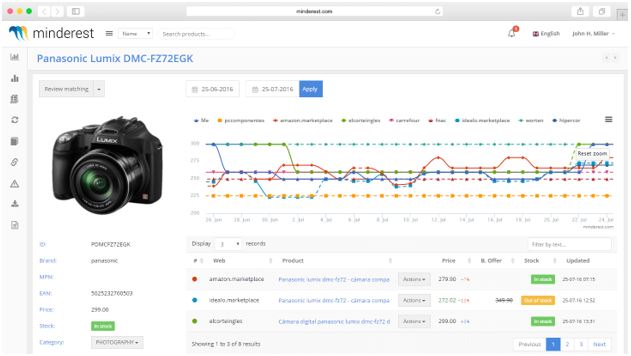 How to apply artificial intelligence to your pricing strategy
How to apply artificial intelligence to your pricing strategy
The current business models are advancing hand in hand with the digital transformation. The integration of new technologies in all areas of a company isn’t optional, but rather a way to be more competitive against other business that are striving to make it to the goal sooner. Within this process of change, the implementation of digital solutions for the optimisation of sales is essential. A good starting point is to establish a dynamic pricing system, a tool that will allow your prices to adapt to the market trends to increase profits.
To implement a dynamic pricing strategy, customer interest and the prices of your main competitors have to be used as key indicators. The comparison of your own prices with those of the competition allows the marketing manager to establish the margin of manoeuvre when modifying them. In this scenario, having a piece of software for the execution and automation of tasks, such as the analysis on consumer behaviour and the prices of other companies in the sector, accelerates decision making and allows for greater profitability.
These computer programs rely on big data to analyse, in real time, a number of variables that can condition sales. As does the dynamic pricing tool from Minderest, which allows you to determine at any time what the best price for products and services is, through the analysis of more than 20 KPIs with a powerful artificial intelligence (AI) model. Each retailer gets exactly the information it needs about its competition and the market. This AI also has machine learning capabilities, making it possible for the decisions made in the past to be taken into account in the present. In this way, your pricing strategy will be progressively perfected while working towards business growth.
Even though dynamic pricing has proven to be highly effective for eCommerce businesses that deal with products and services, it’s also being consolidated in other markets. One example of this is the fact that more and more retail shops have replaced the traditional tag with digital screens that allow them to vary prices more easily and automatically based on the demands of the market.
 Quality information to predict new tendencies and propose actions
Quality information to predict new tendencies and propose actions
The immersion of big data and artificial intelligence in dynamic pricing tools doesn’t only allow the eCommerce business to take action based on a particular event, but also to predict it. Since changes in the market are inevitable, it’s possible to model, interpret, and discuss potential situations before they occur based on the information provided by these digital motors. Thus, the company will be prepared to react to the prices of its competitors as quickly as possible.
Data science and machine learning are also useful for anticipating when and where the competition can pose a threat to your customers. Once such threats have been identified, you can take action to build loyalty and attract users with a personalised shopping experience or with exclusive opportunities, such as a selection of discounts.
Along the same lines, dynamic pricing can be used to reward the brand’s most loyal customers. Thanks to machine learning, the AI will help you predict when your purchases will begin to decline. This will be the time to incentivise them.
Tips for safely implementing a dynamic pricing strategy
Despite the multiple advantages of incorporating dynamic pricing systems into the sales department, you should follow a series of guidelines to avoid it becoming counterproductive. From the outset, an important reputation crisis might be generated if there’s no human team behind the AI and its response algorithms, validating its pricing strategy. There are times when it’s simply not reasonable or appropriate to modify prices in your catalogue of products or services.
On the one hand, constantly changing your prices could lead to customer frustration and abandonment of their trusted eCommerce business. The quest for sales growth must go hand in hand with customer loyalty. Therefore, it’s much more advisable to maintain control over the repricing periods that will occur during the year.
On the other hand, it’s inconvenient and could really offend customers if you raise prices to take advantage of a traumatic situation. One clear example is increasing the price of albums or films after the death of a famous person. Even though the algorithm estimates that an increase can be made because there’s been a peak in demand, the staff behind the software should assess what’s more valuable: the increase in sales or the trust of the shoppers.
In summary, the main piece of advice is to not anger your customers and to use the digital technology that’s available to the company in a reasonable way to enhance sales optimisation and improve profits.
Video – Artificial Intelligence
______________________________________________________
Interesting related article: “What is AI?“

